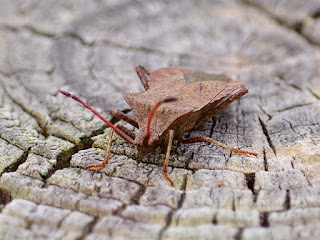The Mute Swans were leading their cygnets around patches of algae on the Long Water.
The Canada gosling was seen alive this morning, on the fallen horse chestnut tree. We looked carefully for it but couldn't find it. I don't think there is any way of catching this elusive little bird and presenting it to its real mother at the other end of the lake.
The swan in the net east of the Lido had was dozing peacefully when a rat tried to get into her nest. She woke up and pecked at it, and it ran off.
The Black Swan was doing a curious shuffle along the slippery edge of the Serpentine. He
is moulting, earlier than the white ones, but of course he is Australian and they do things differently there. You can see the new feathers beginning to emerge on his wings.
Blondie the Egyptian Goose still has her seven young. Their survival is due more to the small number of Herring Gulls on the lake at the moment than to her intermittent attempts at child care.
When the Canada gosling climbed on the swan's back, we thought it was unusual for a goose, but it seems that young Egyptians do the same thing -- though they are not really geese, and their nearest British relatives are Shelducks.
The Bar-Headed Goose is still here. It was in a mixed flock of Greylags and Egyptians near the Dell restaurant, occasionally being chased by the larger Greylags and chasing the smaller Egyptians.
In this dark and distant picture, it looks as if the Great Crested Grebes at the island have two chicks. But this was the only picture of a sequence that showed the second, and it may be a trick of the light.
The two pairs of grebes at the north end of the Long Water, whose territorial frontier is the line of posts, were having a brisk fight after one pair crossed the border. The fourth grebe was just out of the frame in this picture.
A Pied Wagtail was collecting insects beside the Serpentine for a fledgling waiting on a moored pedalo.
A Feral Pigeon discovered an unguarded bowl of chips at the Dell Restaurant, and ate several before their indignant owner noticed and chased it away.
There was a Dunnock in a tree on the west side of the Long Water.
The male Little Owl was on his favourite branch in the chestnut tree.
We hope to see some owlets soon.
This bug was on a post in the reed bed at the east end of the Serpentine. I thought it was a Common Green Shieldbug, Palomena prasena, that was being slow in changing from its winter brown colour to its summer green.
Update: But, as so often, I was wrong. David Element tells me it's is a Dock Bug, Coreus marginatus, 'one of the larger squashbugs'. So glad not to have disappointed readers with one of the smaller squashbugs.












How small and tatty do the Black Swan's wings look. He's incapable of flight right now, isn't he?
ReplyDeleteLet's hope against hope that the little gosling finds its mother. Stranger things have happened!
Yes, of course he can't fly with wings in that state. But in two or three weeks he'll be blasting around while the Mute Swans are grounded. Large numbers of Greylag and Canada Geese come here in June to moult their flight feathers in the relative safety of the lake. The lee shore is thick with shed feathers, and anyone wanting some quill pens is spoilt for choice.
DeleteHe's going to be (even more of a) King of the Hill, or the Lake as the case might be.
ReplyDeleteI used to collect feathers (long story short - I used to buy them, and then stopped because I wasn't sure that they were ethically collected), and I would jump at the opportunity of having some Geese feathers for my collection. I think I suffer from Feather Envy.
My prize feather is a massive pinion from a Griffon Vulture an acquaintace who worked in a wildlife hospital gifted us.
I've collected some feathers too, including some shed by one of the Tawny Owls when its owlets' lunch fought back. By the way, we are as far from ever from finding these owls, despite a sighting a couple of weeks ago.
DeleteHi Ralph, your bug is more uncommon, I'm pretty sure is a Dock Bug, check this website for details http://www.britishbugs.org.uk/heteroptera/Coreidae/coreus_marginatus.html
ReplyDeleteThanks. It was also identified as a Dock Bug by David Element. I had looked for it on an identification site and missed it. Curiously, there isn't much dock in the park for it to eat -- as many parents whose children have stung themselves on nettles have discovered when looking for the traditional remedy.
Delete